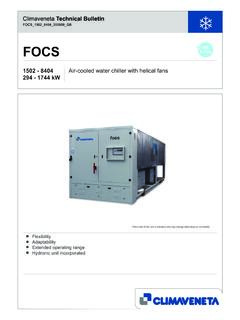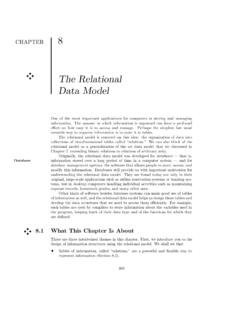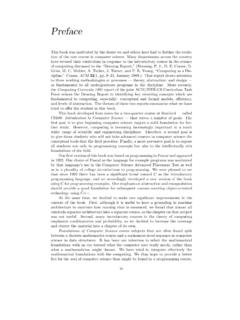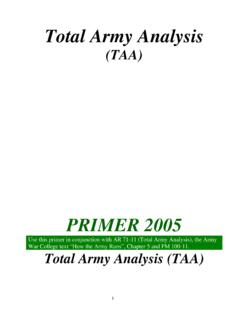Transcription of Lecture 1: Theory of the rm - willmann.com
1 Lecture 1: Theory of the firm Technology Cost minimization Profit maximization Let's briefly mention one interesting issue before we start: why are there companies, many individuals working together in one organization? Exciting question which unfortuantely we have to postpone. For the moment we accept the existence of companies as given and try to formalize the environment they face (-> technology) and their objectives (cost minimization or more generally profit maximization). Gerald Willmann, Department of Economics, Universit at Kiel 1. Technology Technology are the hard facts of life companies face. It hasn't much to do with economics (it's rather engineering) but we need a formalization or description. Think of it as a black box converting inputs into outputs. Outputs Inputs Blackbox Since more than one output would be hard to handle, we will always assume that companies produce only one output (or can be subdivided into units that do).
2 That is, we abstract from economies of scope (= synergies of producing several things together). Gerald Willmann, Department of Economics, Universit at Kiel 2. With only one output we can formalize the production process as a function Y = f (K, L, ..) where Y is output quantity and K, L, .. are input quantities. With only one input this is easy to depict graphically: Y. f(K). K. But with more than one input 2-dimensional graphics become tricky. For example, with 3 inputs we would have 4 dimensions (3 inputs plus output). which would hardly fit onto a page. Gerald Willmann, Department of Economics, Universit at Kiel 3. The case of 2 inputs is still manageable, however. L. Y3. Y2. Y1. K. Instead of the 3-dimensional production function (2 inputs + 1 output = 3) we depict production isoquants which are defined by Y = f (K, L) for different Y s.
3 Same concept as altitude lines on geographical maps. Gerald Willmann, Department of Economics, Universit at Kiel 4. Characteristics of technology Marginal Product: how does output change if we increase one input marginally. mathematically: f (K, L, ..). M PK =. K. f (K, L, ..). M PL =. L. If you think of the 2-input prod fct as a mountain this is its slope in one direction. The marginal product will usually be positive though decreasingly so. Diminishing MP is a standard assumption. In the extreme it could become negative if you send the 1000th farmhand onto a field he/she might reduce output. Returns to scale: how does output change if we increase all inputs marginally, scale up production in other words. Gerald Willmann, Department of Economics, Universit at Kiel 5. mathematically (for homogeneous prod fcts): f ( K, L.)
4 ??? f (K, L, ..). In case the LHS > RHS we speak of increasing returns to scale (IRS), equality corresponds to constant returns to scale (CRS), and LHS < RHS is called decreasing returns to scale (DRS). Again in terms of our 2-input production mountain, this tells us the slope if we climb diagonally (increasing both inputs) proportional to the increase in inputs, or more/less than proportional. How does this concept relate to the distances between isoquants? free disposal = more inputs cannot reduce output (one could throw inputs away or dispose of them, after all). no free lunch = without inputs no positive output Gerald Willmann, Department of Economics, Universit at Kiel 6. Cost Minimization We assume/consider a company trying to achieve the following objective: produce a given output quantity at minimal cost.
5 The company is a small player and takes prices (for inputs as well as output) as given no market power on either side. Note that with one input this is really easy: the prod fct tells us how much of the one and only input we need and at a given factor price this input quantity has its cost. Not much of a minimization. The problem becomes interesting only if production requires at least two inputs. In fact, for simplicity, we will mostly limit ourselves to the case of two inputs. Then the problem is finding the cheapest input mix resulting in the required output. Gerald Willmann, Department of Economics, Universit at Kiel 7. Mathematically: minK,L rK + wL (that's the objective). subject to ( from now on): Y = f (K, L) (constrained by the hard facts of life). We solve this constrained optimization problem by setting up the Lagrangean: L = rK + wL + (Y f (K, L)).
6 These are the problem's first order conditions (FOCs): L. = r fK = 0. K. L. = w fL = 0. L. Gerald Willmann, Department of Economics, Universit at Kiel 8. dividing one by the other gives: r fK. = M RT S. w fL. where MRTS is shorthand for the marginal rate of technical substitution. Note that we have two equations the constraint as well as relative input price equals MRTS in two unknows (K and L). This system can be solved to obtain the so-called conditional (b/c they are conditional on the output quantity) factor demands: K(w, r, Y ) and L(w, r, Y ). Gerald Willmann, Department of Economics, Universit at Kiel 9. Graphically: L. given Y. isocost K. The slope of the isoquants is the MRTS (totally differentiating Y = f (K, L) will tell you that) while the slope of the isocost lines is just the relative input price r/w (again totally differentiate its definition, C = rK + wL, to see this).
7 Plug the conditional factor demands back into the definition of cost (rK + wL) to obtain what is called the (minimal) cost function: C(w, r, Y ) rK(w, r, Y ) + wL(w, r, Y ). Gerald Willmann, Department of Economics, Universit at Kiel 10. We have solved now the cost minimization problem. Its solution is the cheapest input combination (K(w, r, Y and L(w, r, Y ) and the cost function tells us what the cheapest way to produce a given output quantity actually costs. A few more things about cost: first two definitions: C(w,r,Y). C. AC. MC. C. (marginal cost)M C . Y Y. MC, AC MC. AC. C. (average cost)AC . Y Y. To show that MC must intersect AC in the latter's minimum note that said minimum is characterized by AC/ Y = 0. Using the definition of AC. ( C(Y )/Y ) and explicitely calculating the first order condition should lead you to the desired result.))
8 Intuitively, M C pulls down AC as long as its below and pulls it up once it's above. Gerald Willmann, Department of Economics, Universit at Kiel 11. Characteristics of the cost function: . C(w, r, Y ). = L(w, r, Y ). w C(w, r, Y ). = K(w, r, Y ). r due to the envelope theorem linear homogeneous in factor prices concave in prices Relationship between M C and returns to scale: CRS corresponds to constant M C. IRS corresponds to decreasing M C. DRS corresponds to increasing M C. relate C(Y = 1) vs. C(Y = 2) vs. C(Y = 3) to the changing distances between isoquants to see this. Gerald Willmann, Department of Economics, Universit at Kiel 12. Profit Maximization Output is no longer given. We assume that a company chooses inputs and output in order to maximize profits. This is the standard assumption regarding firms'.
9 Behavior. There are alternatives say maximizing sales b/c that maximizes a CEO's prestige but one can show that if some maximize profits while others do strange things the former will dominate. How does profit maximization relate to cost minimization: we will show below that the former implies the latter but not vice versa. That is, a profit maximizing firm always minimizes costs (how else could the profit maximizing output be really profit maximizing) but a cost minimizer does not necessarily maximize profits (simply because the given output might not be the profit maximizing one). Gerald Willmann, Department of Economics, Universit at Kiel 13. Mathematically: max profit = pY rK wL. K,L,Y. Y = f (K, L). There are (at least) three ways of solving this optimization: 1. plain Lagrange 2. substitute the constraint into the objective 3.
10 Short-cut via cost minimization Gerald Willmann, Department of Economics, Universit at Kiel 14. 1. Forget the first way. It is possible but unnecessarily complicated. Lagrange adds one dimension to the problem due to the multiplier. You would end up with a constrained maximization over inputs, output, and the multiplier . unnecessarily painful. 2. The second way instead reduces the problem by one dimension (we substitute the constraint into the objective and thereby get rid of output) and in addition leads to an unconstrained maximization. Let's briefly see how it works for 2. inputs (because this will prove that profit max implies cost min) and then make life even easier and do it for only one input. max K, L = pf (K, L) rK wL. FOCs: . K: = pfK r = 0. K.. L: = pfL w = 0. L. Gerald Willmann, Department of Economics, Universit at Kiel 15.







